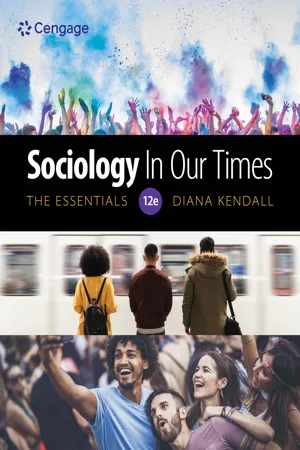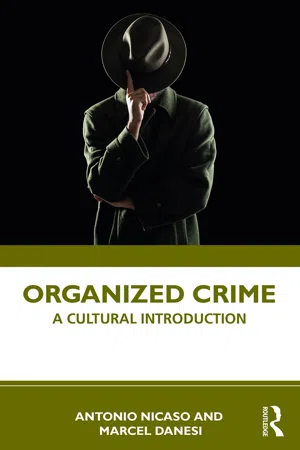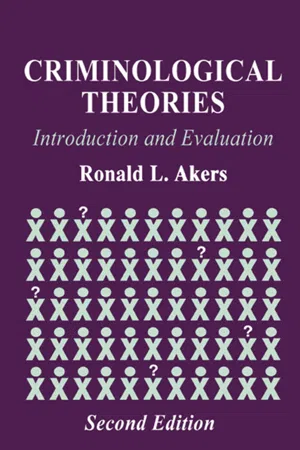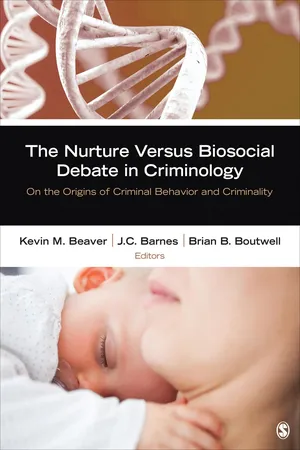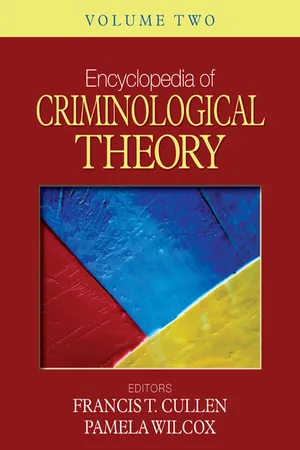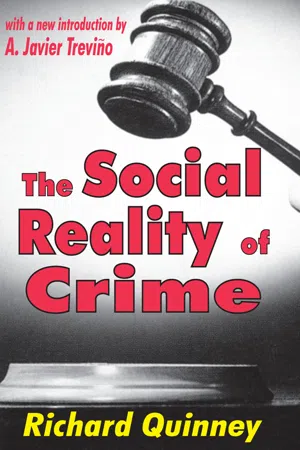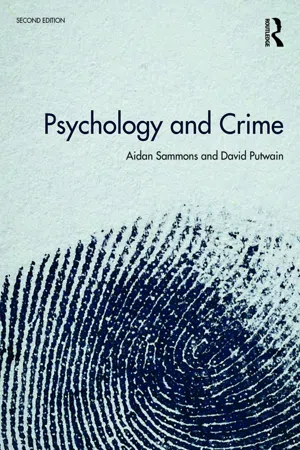Psychology
Differential Association Theory
Differential Association Theory, proposed by Edwin Sutherland, suggests that criminal behavior is learned through interactions with others. Individuals are more likely to engage in criminal activities if they are exposed to favorable attitudes and definitions of such behavior. This theory emphasizes the role of social environment and peer influence in shaping an individual's likelihood of engaging in criminal behavior.
Written by Perlego with AI-assistance
Related key terms
1 of 5
10 Key excerpts on "Differential Association Theory"
- eBook - PDF
- Diana Kendall(Author)
- 2020(Publication Date)
- Cengage Learning EMEA(Publisher)
Differential Association Theory states that people have a greater tendency to deviate from societal norms when they frequently associ- ate with individuals who are more favorable toward deviance than conformity. From this approach, criminal behavior is learned within intimate personal groups such as one’s family and peer groups. Differential Association Theory con- tributes to our knowledge of how deviant behavior reflects the individual’s learned techniques, values, attitudes, motives, and rationalizations. It calls attention to the fact that criminal activity is more likely to occur when a person has frequent, intense, and long-lasting interactions with others who violate the law. However, it does not explain why many individuals who have been heavily exposed to people who vio- late the law still engage in conventional behavior most of the time. Criminologist Ronald Akers (1998) has combined Differential Association Theory with elements of psychological learning theory to create differential reinforcement theory, which suggests that both deviant behavior and conventional behavior are learned through the same social processes. Akers starts with the fact that people learn to evaluate their own behavior through interactions with significant oth- ers. If the persons and groups that a particular individual considers most significant in his or her life define deviant behavior as being “right,” the individual is more likely to engage in deviant behavior; likewise, if the person’s most significant friends and groups define deviant behavior as “wrong,” the person is less likely to engage in that behavior. This approach helps explain not only juvenile gang behav- ior but also how peer cliques on high school campuses have such a powerful influence on teenagers’ behavior. - eBook - ePub
Organized Crime
A Cultural Introduction
- Antonio Nicaso, Marcel Danesi(Authors)
- 2021(Publication Date)
- Routledge(Publisher)
Differential Association Theory claims, in a phrase, that an individual who joins a criminal gang is influenced to do so by observing other individuals who are believed to be “in the know” and because there is pressure to join from peers in the gangs. Interactions with the gang are seen as shaping the individual’s understanding of how the OC provides a means to belong to something meaningful.Differential Association Theory
- 1 Criminal behavior is learned via a process of interaction and intercommunication with criminals.
- 2 Developing criminal behavior involves learning the techniques, motives, drives, rationalizations, and attitudes of the gang members through a form of peer pressure.
- 3 An individual does not necessarily become a criminal under peer pressure, but he will be predisposed by such pressure to rationalize his choice to join.
- 4 Mechanisms of rationalization are activated early on, allowing the individual to justify his choice of criminality, including explaining why he veered towards the crime group.
- 5 An individual becomes predisposed to criminality when there is no clear condemnation of the criminal lifestyle in his environment – a situation that leads to what is called the “social proofing” of the individual, who is inclined to assume that the criminals possess more knowledge about the world than anyone else.
- 6 Differential associations vary in frequency, duration, priority, and intensity, affecting if and how a prospective gangster will behave.
Differential Association Theory does not suggest, however, that the mere interaction with criminals will invariably lead an individual to criminal behavior. It assumes intentionality on the part of the individual, whereby he might come to see deviance in social behavior as “normal.” Sunderland’s theory was elaborated on by sociologists Robert Burgess and Ronald Akers in 1966, calling their version, differential-reinforcement theory. They cast aside Sutherland’s view that criminal behavior was learned in primary reference groups (those in an individual’s environment), indicating that it can be acquired in various kinds of situations outside the primary environment. In addition, they suggested that criminal behavior could result from non-social factors, such as the influence of drugs on an individual’s psychological and social mindset, which could contribute to the adoption of deviant behavior by the individual. Moreover, an individual might make a rational decision to join a gang not just through imitation but also on the basis of past experiences in order to calculate the effectiveness of his future behaviors. The latter view is part of so-called rational choice theory - eBook - ePub
Social Learning and Social Structure
A General Theory of Crime and Deviance
- Ronald Akers(Author)
- 2017(Publication Date)
- Routledge(Publisher)
The first focuses on the situation (or the personal pathologies of individuals), and the latter focuses on the processes existing before the situation (not the biological meaning of genetic). The Differential Association Theory was in this sense more a genetic than a mechanistic theory of factors at work in the immediate circumstances. However, differential association operates at the nexus of the "person-situation complex" because the situation is defined "by the person in terms of the inclinations and abilities which the person has acquired up to that date" (Sutherland, 1947:5) The final version of Differential Association Theory (Sutherland, 1947:6-7) was presented in a nine-statement format, with accompanying commentary: 1 Criminal behavior is learned. Negatively, this means that criminal behavior is not inherited, as such; also, the person who is not already trained in crime does not invent criminal behavior, just as a person does not make mechanical inventions unless he has had training in mechanics. Criminal behavior is learned in interaction with other persons in a process of communication. This communication is verbal in many respects but includes also "the communication of gestures." The principal part of the learning of criminal behavior occurs within intimate personal groups. Negatively, this means that the impersonal agencies of communication, such as movies and newspapers, play a relatively unimportant part in the genesis of criminal behavior. When criminal behavior is learned, the learning includes (a) techniques of committing the crime, which are sometimes very complicated, sometimes very simple, and (b) the specific direction of motives, drives, rationalizations, and attitudes. The specific direction of motives and drives is learned from definitions of the legal codes as favorable or unfavorable. In some societies an individual is surrounded by persons who invariably define the legal codes as rules to be observed, while in others he is surrounded by persons whose definitions - eBook - ePub
Criminological Theories
Introduction and Evaluation
- Ronald L. Akers(Author)
- 2013(Publication Date)
- Routledge(Publisher)
Today we would interpret differential social organization as a macro-level or structural theory, and differential association as a compatible micro-level or processual theory. Sutherland gave only brief attention to differential social organization, however, and concentrated his efforts on fully explicating differential association. The theory as he finally stated it (Sutherland, 1947 :6–7) is as follows: Criminal behavior is learned. Criminal behavior is learned in interaction with other persons in a process of communication. The principal part of the learning of criminal behavior occurs within intimate personal groups. When criminal behavior is learned, the learning includes (a) techniques of committing the crime, which are sometimes very complicated, sometimes very simple, and (b) the specific direction of motives, drives, rationalizations, and attitudes. The specific direction of motives and drives is learned from definitions of the legal codes as favorable or unfavorable. A person becomes delinquent because of an excess of definitions favorable to violation of law over definitions unfavorable to violation of law. Differential associations may vary in frequency, duration, priority, and intensity. The process of learning criminal behavior by association with criminal and anti-criminal patterns involves all of the mechanisms that are involved in any other learning. Although criminal behavior is an expression of general needs and values, it is not explained by those general needs and values, because noncriminal behavior is an expression of the same needs and values. The first proposition is that criminal behavior is learned, and the terms “learned” and “learning” are included in other statements. Criminal behavior is learned in a process of symbolic interaction with others, mainly in primary or intimate groups - No longer available |Learn more
- David Canter(Author)
- 2017(Publication Date)
- Routledge(Publisher)
An interesting and important aspect of Sutherland’s theory is that criminals are not seen as having different needs or values from non-criminals. It is how they interpret and act on those needs and values that distinguishes them. This contrasts with the biological and many of the psychological explanations reviewed in earlier chapters. Those explanations suggest there is something radically different about criminals. Sutherland’s theory does not.Sutherland’s theory, then, is called Differential Association Theory because it postulates that it is the relationships with a particular subset of people, who are different from the law-abiding majority, which is the main cause of criminality. It is regarded as a general theory for all crimes, but its focus is on how young people become involved in crime. The emphasis is on how delinquency is learned through a process of communication with other people – usually small intimate peer groups (Coleman & Norris, 2000). However, a wider range of illegal activity has been explained using the idea of differential association. For example, Chappell and Piquero (2004) have shown it helps to explain police corruption. Also, Akers and Silverman (2004) have argued that terrorists are influenced to carry out their violent actions by accepting an ideology and identity generated from contact with peers and membership of reference groups, where attitudes, beliefs and values justify violence as a means to a worthwhile end.The consideration of terrorism points to the fact that the learning of criminal behaviour does not have to develop through association with criminals, but with people who support or imply favourable attitudes to illegal activity. For example, parents may be teaching their children to be dishonest by not reporting an error in payment for a purchase, even if they constantly tell their children that it is wrong to steal. Or, in the terrorist context, parents may insist that their children are religiously orthodox, sowing the seeds for a radical interpretation of what that might mean. - eBook - ePub
The Nurture Versus Biosocial Debate in Criminology
On the Origins of Criminal Behavior and Criminality
- Kevin M. Beaver, J.C. Barnes, Brian B. Boutwell, Kevin M. Beaver, J. C. Barnes, Brian B. Boutwell(Authors)
- 2014(Publication Date)
- SAGE Publications, Inc(Publisher)
PART IITHEORETICAL PERSPECTIVESPassage contains an image
7Learning Theories of CrimePromises and PotentialJonathan R. BrauerUniversity of Nebraska at OmahaJonathan D. BolenUniversity of Nebraska at OmahaA Brief History of Learning Theories of CrimeIn 1939, Edwin Sutherland advanced criminological theory by presenting an explicit statement of Differential Association Theory in the third edition of his Principles of Criminology textbook. Dissatisfied with the fragmented multiple factor explanations that were common in American criminology at the time, Sutherland developed the principles of differential association with the goal of providing a general theory that promised to explain all known patterns of crime (Sutherland, 1973). The basic premise was attractively simple; he posited that criminal behavior, like all human behavior, is learned via communication and interaction within social groups. Differential Association Theory was not the first general social theory to depict crime as learned behavior—in the late 19th century, French sociologist Gabriel Tarde (1903/1962) postulated that criminal behaviors are learned through a general process of behavioral imitation (see also Rafter, 2011). However, the original statement of Differential Association Theory and its later refinements (e.g., Sutherland, 1947, 1973; Sutherland & Cressey, 1966) now constitute one of the most well-known, oft-tested, and widely supported theories of crime (Akers, 2009; Matsueda, 1988).Differential Association Theory (DAT) assumes that societies contain conflicting normative codes and that individuals learn specific values primarily though frequent interactions within salient social groups. The theory posits that the likelihood of an individual engaging in criminal and deviant behaviors depends on the relative exposure to social patterns that are favorable versus unfavorable to law violating behavior. Associations with criminal patterns are expected to result in the learning of specific techniques and skills necessary to engage in crime and in learning crime-favorable cognitive definitions, which include motives, drives, or rationalizations that define crime as appropriate in certain situations. Individuals who commit crime, then, presumably have learned requisite techniques and an excess of definitions marking criminal behavior as appropriate in certain situations, through frequent exposure to salient criminal patterns (Sutherland & Cressey, 1966). - eBook - ePub
- Kimberly Cook(Author)
- 2019(Publication Date)
- Routledge(Publisher)
7 Theoretical DiversityChapter Outline
7.1 Social Learning Theory
Stemming from the weak areas within Differential Association Theory, Akers developed the Social Learning Theory as it relates to deviant behavior in order to explain how and why individuals engage in criminal behavior. Using the lessons from Behavioral Psychology, Akers adapted the theory and concepts to explain deviance as a Social Learning theory. The starting point is that social behavior, counter to other theories, is a cognitive process where personality and environment reciprocally interact. Learning is accomplished through rewards and punishments as well as observations, according to this theory.Differential Reinforcement
C. Ray Jeffery's theory of differential reinforcement states that a criminal act occurs in an environment where the actor has been reinforced for behaving in this manner, and the aversive consequences have not successfully dissuaded further behavior. [This does not indicate why the individual did the behavior in the original instance.] According to follow-up research by Burgess and Akers, social behavior responds to a complicated set of stimuli, rewards, and punishments. Criminal behavior is learned in seven stages: direct conditioning or imitation; through social interaction with others; in small groups; with effective and available reinforcers; the norms to which those reinforcers are applied; when the normatively applied behavior is more highly reinforced than non-criminal behavior; and results from the amount, frequency and probability of reinforcements. The theory must explain all seven of these stages. There are two basic components to the theory: - eBook - PDF
- Francis T. Cullen, Pamela Wilcox, Francis T. Cullen, Pamela K. Wilcox(Authors)
- 2009(Publication Date)
- SAGE Publications, Inc(Publisher)
A key issue is how to measure an excess of definitions favorable to crime, a prerequi-site for testing the theory. Long ago, Matsueda argued that if definitions of law violation can be viewed as a single continuum, they can be treated as a latent variable with operational implications for fallible survey measures of definitions. This strategy 901 Sutherland, Edwin H.: Differential Association Theory and Differential Social Organization found that definitions of delinquency mediated effects of parent and peer attachment on delinquent behavior, and therefore that differential association is supported over social control theories for non-black (Matsueda, 1982) and black youths (Matsueda & Heimer, 1987). Panel studies have also supported the hypothesis that definitions are causally linked to delinquency and violence for males and females (Heimer & DeCoster, 1999) and that techniques for monetary crimes are important (McCarthy, 1996). Empirical research has also found some support for the hypothesis that differential reinforcement adds explanatory power in models of delinquency. The concepts of imitation and anticipated social rewards from crime appear to add to the explana-tion of delinquency. Finally, recent research sug-gests that delinquent peer association has a smaller effect on delinquency when estimated longitudi-nally, when disentangling peer selection from peer effects, and when measuring delinquent peers from the peers themselves. Dana Haynie has linked dif-ferential association to social network theory and found that network density and centrality of delin-quent peer groups are key predictors of delin-quency. In sum, most empirical research finds general support for differential association and social learning theories. - eBook - ePub
- Wilhelm Roepke, Richard Quinney(Authors)
- 2017(Publication Date)
- Routledge(Publisher)
Each person constructs his own “reality world,” his own view of himself and all that is about him. However, it is only as he participates in the worlds of others that he is able to develop his own world. In other words, by occupying space with others in a social setting, we share a common symbolic environment.While the reality world of each individual is his and his alone, it does, of course, have many aspects in common with the reality worlds of other people. The extent to which our reality worlds are alike seems to depend on the extent to which we have shared similar experiences and similar purposes.12Shared meanings are provided for most persons by membership in some kind of social group. According to reference group terminology, social groups furnish members with a frame of reference for the organization of perceptions and experiences.13 Persons act, then, in reference to the perspectives of their groups. Furthermore, the actions of persons are in part an attempt to preserve and enhance social status within their groups. Consequently, an explanation of variations in the behavior of persons may be sought in the context of group experiences.The theory of differential association provides such an explanation of “criminal” behavior.14 In this view, all persons acquire their behavior during associations with others. Some, however, become criminal because the substance of their associations involves an excess of definitions favorable to the violation of the law. The theory of differential association is thus an extension of the basic theoretical perspective of the socialization process that occurs in the context of primary groups.15 The learning of “criminal” behavior patterns is not fundamentally different from other socialization during which the individual is differentially exposed to various norms regarding some socially significant form of behavior.The problem in the theory of differential association, however, has been not so much theoretical as empirical. Few systematic guides are provided for empirical verification of the theory. Moreover, the theory was formulated at such a high level of abstraction that it has not been possible to test it with empirical data. At best, it has been subject only to partial testing through research on the variables of association, including the frequency, duration, priority, and intensity of association. On the basis of these limited studies, nevertheless, it has been shown that persons who associate with delinquents (however defined) report more or engage in more alleged delinquent behavior than those who associate with others.16 - eBook - PDF
Psychology and Crime
2nd edition
- Aidan Sammons, David Putwain(Authors)
- 2018(Publication Date)
- Routledge(Publisher)
chapter 5 Socially oriented explanations of offending 52 criminals and others not because of the different people they associate with (Suther-land, 1939). SLT starts from the same assumption: that criminal behaviour is qual-itatively no different from any other sort and is learned from other people. It was developed as a general theory of behaviour by Bandura (1977) and as a theory of criminal behaviour by Akers (1973). In simple terms, an individual learns deviant ways of thinking and acting by observing the people around them. Whether they then imitate these ways of thinking and acting depends on the extent to which they are reinforced for doing so. A reinforcement is any consequence that makes a behaviour stronger. Akers specified four key factors in the development of deviance and criminality: ■ Differential association (i.e. the people from whom behaviour is learned). ■ Imitation (i.e. the process of acquiring attitudes and behaviour from others). ■ Definitions (i.e. the attitudes and values that support offending). ■ Differential reinforcement (i.e. the perceived consequences of imitation). Imagine a young person who starts to associate with a peer group that shoplifts. Within the group they are exposed to pro-criminal attitudes such as, ‘no-one loses out – the shops don’t even notice the stuff has gone.’ They are also told about, or may observe directly, members of the group stealing things. They may be told about ways of not getting caught. Whether the person starts to imitate these attitudes and behaviours depends on whether she expects that she will be reinforced. Reinforce-ments might be approval from other group members or material gains from steal-ing. If criminal attitudes and behaviours are competing with non-criminal attitudes and behaviours whichever receives stronger or more frequent reinforcement will win out.
Index pages curate the most relevant extracts from our library of academic textbooks. They’ve been created using an in-house natural language model (NLM), each adding context and meaning to key research topics.
